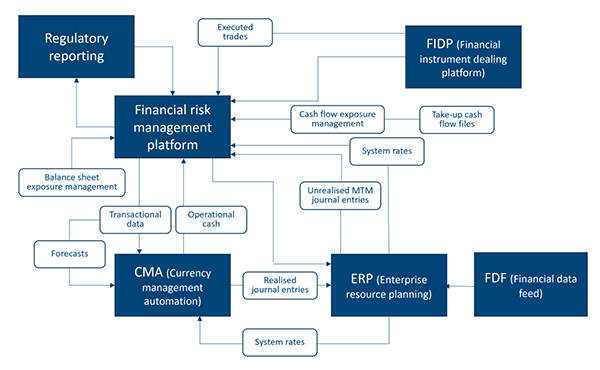
In today’s ever-accelerating technology landscape, global treasury teams are leveraging turnkey integration to take advantage of specialised tools offering superior performance in key areas across front, middle, and back offices. This shift from the ‘all-in-one’ vs ‘best-of-breed’ conversation to one emphasising connectivity and interoperability stems from the recognition that no single platform can address all the needs of a modern treasury function.
It also reflects the treasurer’s continued expansion into a more strategic, higher visibility role on the corporate leadership team.
Over the last several years, treasury teams raised their profiles and earned a seat at the table for enterprise-level strategic conversations with senior management, boards of directors and investors. To deliver the financial performance metrics and analyses these senior stakeholders require, many expanded their technology capabilities and integrated treasury platforms within the corporate-wide technology infrastructure.
This technology stack often includes an enterprise resource planning (ERP) system, a financial risk management platform, financial planning and analysis (FP&A) and financial modelling software, cash forecasting and liquidity tools, electronic banking and payment systems, supply chain financing technology, general ledger accounting automation, and more.
Finance and treasury teams harness this diverse set of technologies to employ data-driven scenario planning, enhance decision-making, adopt innovative approaches, streamline processes and improve controls. The result is an advanced ecosystem where leadership can synthesise data from multiple systems to inform the organisation’s strategic direction.

As treasury practitioners evaluate the transformative potential of artificial intelligence, machine learning and robotic process automation, they consider its role in data-driven decision-making and process automation. They also continue to leverage advanced business intelligence (BI) to visualise data, inform decision-making and quantify programme performance.
With current and potential technology partners incorporating these innovations into new capabilities, treasury teams need the agility to select the right system for their organisation, one that offers the most advanced insights and efficiencies. Connected treasury ecosystems enable treasury teams to incorporate relevant innovations as they emerge, rather than locking the organisation into large legacy systems that may not keep pace with advancements.
This flexibility is crucial in maintaining a competitive edge and ensuring that the treasury function can adapt to new technologies and market conditions swiftly.
In addition to integrating advanced technologies, treasury teams are increasingly turning to data analytics to drive more informed decision making. By harnessing the power of big data, treasurers can gain deeper insights into market trends, identify potential risks before they materialise and optimise liquidity management strategies. Advanced analytics tools enable the aggregation and analysis of vast amounts of financial data, providing a comprehensive view of the organisation's financial health.
This level of insight allows treasury teams to make proactive, strategic decisions that align with corporate goals, ultimately contributing to more robust financial performance and stability. Embracing data analytics not only enhances the decision-making process but also strengthens the overall strategic impact of the treasury function within the organisation.
When assessing the potential of an integrated treasury technology stack, it’s important to note that establishing secure connections across different financial tools is now easier than ever. You no longer need to choose between using the best software for specific tasks and dealing with integration difficulties.
With the proliferation of APIs (application programming interfaces), more consistent SFTP (secure file transfer protocols) standards and a growing number of companies providing ETL (extract, transform and load) capabilities, your organisation can confidently select the best tools for specific jobs, knowing you can integrate these platforms with significantly less effort than before.
The trend toward connected technology systems both reflects and enhances treasury’s strategic role within the organisation. By selectively incorporating advanced technologies that fit organisational needs, treasury teams can gain unprecedented insights and efficiency.
Today’s financial risk management technology allows treasury teams to evaluate and incorporate essentials like automated exposure management, hedge flattening, long-haul hedge accounting and advanced management reporting without disrupting the overall treasury technology infrastructure. This approach offers a strategic advantage to forward-thinking treasury organisations.
The interconnected nature of modern treasury platforms ensures that organisations are better prepared for future technological advancements and regulatory changes. This agility allows treasury teams to quickly adapt to new market conditions, implement innovative financial strategies and maintain compliance with evolving standards.
By embracing a modular approach to technology, treasurers can remain at the forefront of industry developments, ensuring long-term resilience and competitive advantage. Ultimately, this strategic adaptability not only enhances operational efficiency but also positions treasury functions as pivotal contributors to overall corporate success. As the financial landscape continues to evolve, forward-thinking treasurers will be well-equipped to navigate the complexities and seize opportunities for growth.
As treasury functions continue to evolve in an increasingly complex and dynamic financial environment, the importance of embracing modular, interconnected technology platforms cannot be overstated. By leveraging specialised tools and advanced technologies, treasury teams can significantly enhance their ability to manage risks, make informed decisions, and drive strategic initiatives.
The shift from monolithic systems to agile, best-of-breed solutions empowers treasurers to remain adaptable and competitive, ensuring they are well-prepared for future challenges and opportunities. In this context, exploring modular, tailored financial risk management solutions becomes essential for treasurers aiming to confidently manage financial risks and make informed decisions.
Jackie Bowie is a managing partner and head of EMEA at Chatham Financial

